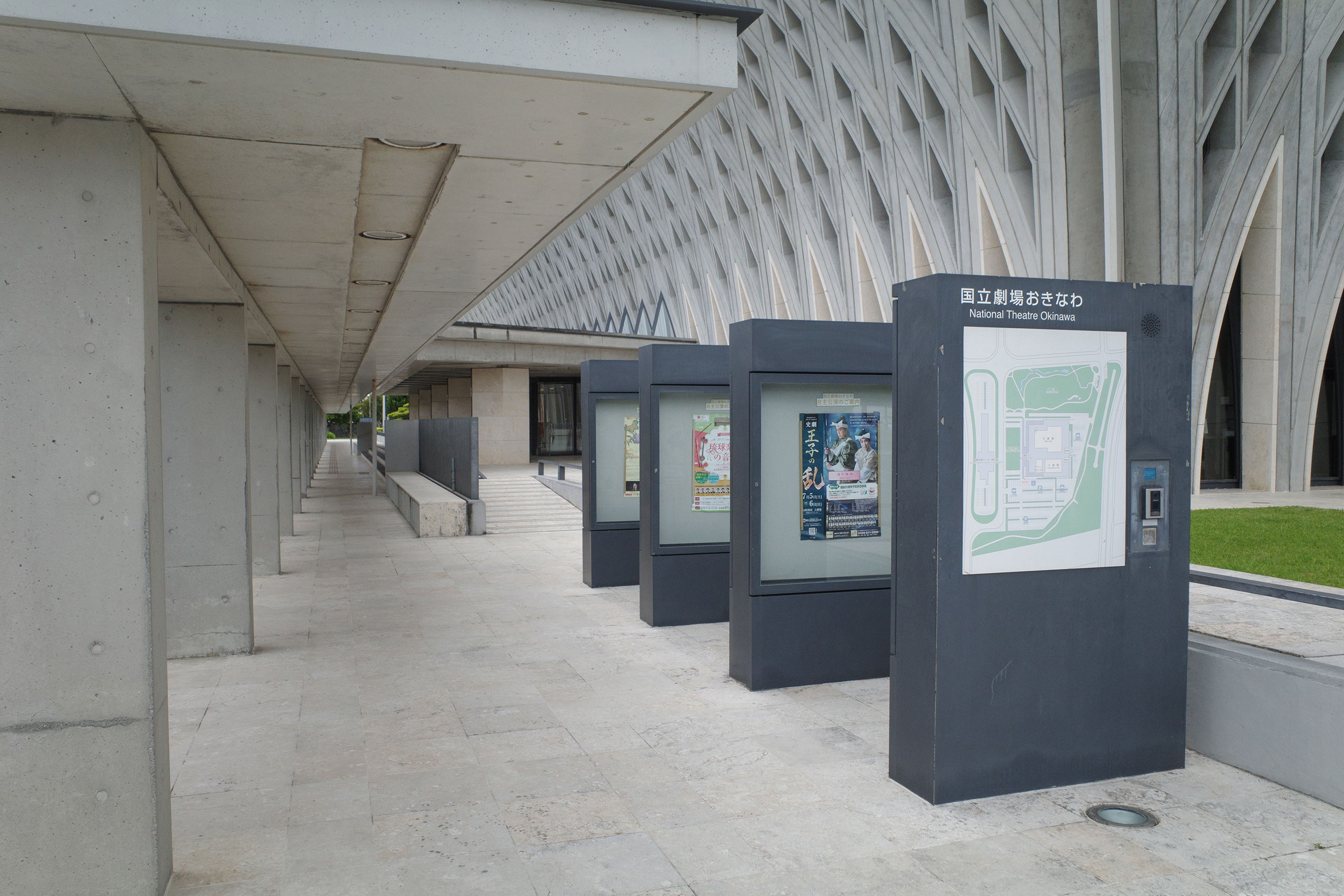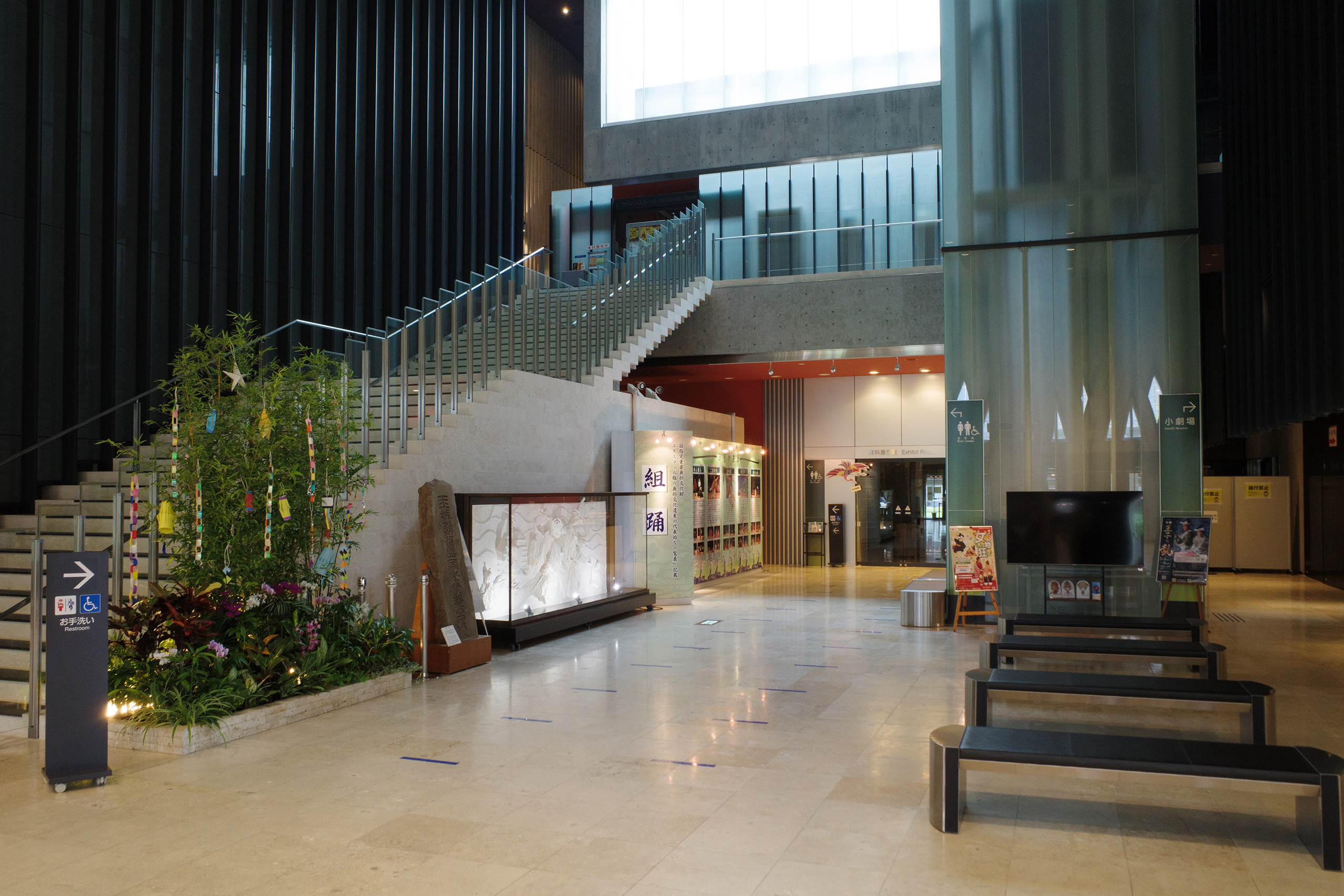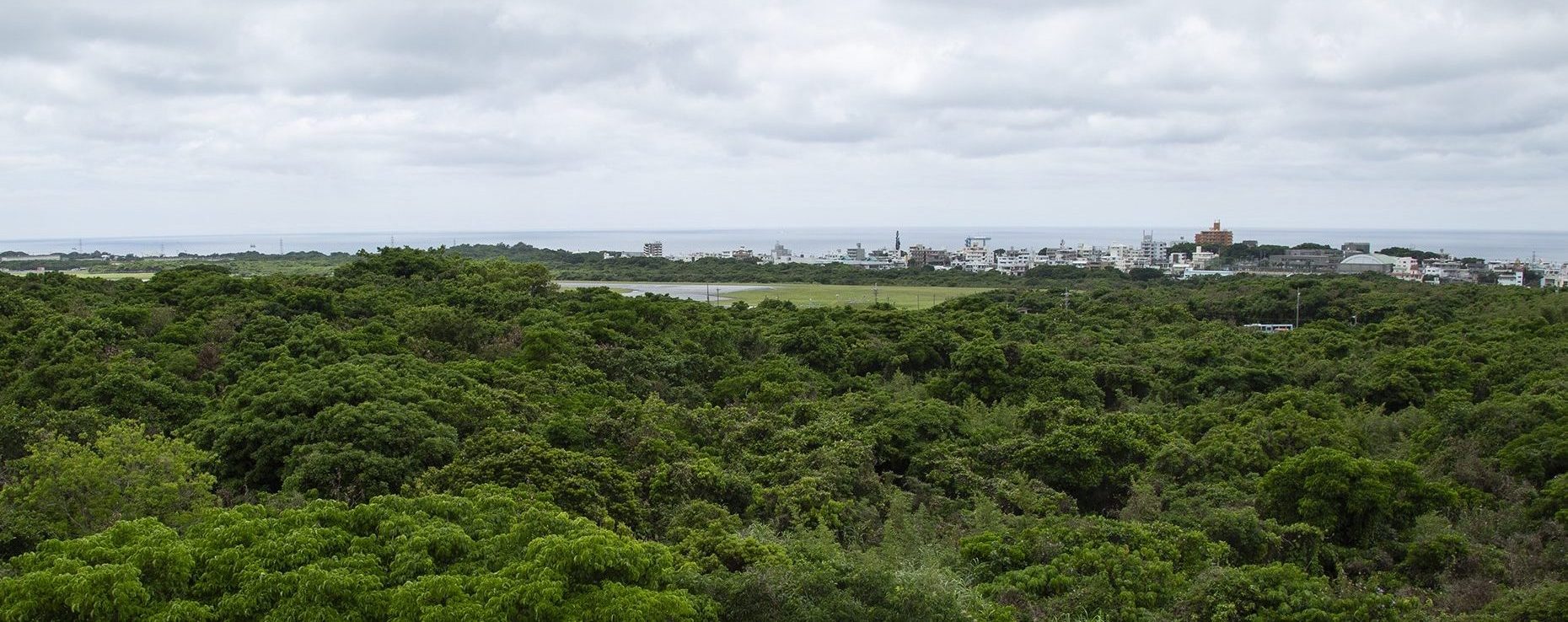
Shinji Kinjo / Erina Nakamine / Amy Hiraoka / Yoshiko Murakami
Exploring Okinawa through the Performing Arts (2): National Theatre Okinawa, Naha Cultural Arts Theater NAHArt, and essential cultural spots
Photo: Naoko Kitaue
An independent state from the fifteenth to nineteenth centuries—known as the Ryukyu Kingdom—Okinawa still retains its own unique traditions and culture, having been incorporated into Japan in the modern era. It was the site of a brutal land battle in World War II, and was then placed under American control after hostilities ceased, before its reversion to Japan in 1972. Its development has continued even while hosting vast US military bases, and various arts and cultural facilities have been established since the turn of the twenty-first century.
This feature introduces the hall of the Himeyuri Alumnae Building, now overseen by a seasoned producer with over half a century of experience presenting controversial works from Okinawa, to a city-run cultural complex in Naha that includes both small and large theaters and opened its doors during the COVID-19 pandemic. It comprises interviews with key figures involved in running five theaters and halls that have opened since 2000; a column introducing essential cultural spots in the region; and a deep dive into the work and life of Takuya Kaneshima, a leading Okinawan playwright born in the Heisei era. We will explore the latest in Okinawa’s performing arts scene over three installments, each from a different perspective.
The second part includes interviews with key figures from the other two public theaters and introduces incredibly inspiring and educational sites that are essential for anyone wanting to learn about Okinawa’s performing arts world. (See the first article here.)
Interview/text: Junichi Maeshiro
English Translation: Ben Cagan, Hibiki Mizuno (Art Translators Collective)
④National Theatre Okinawa
-
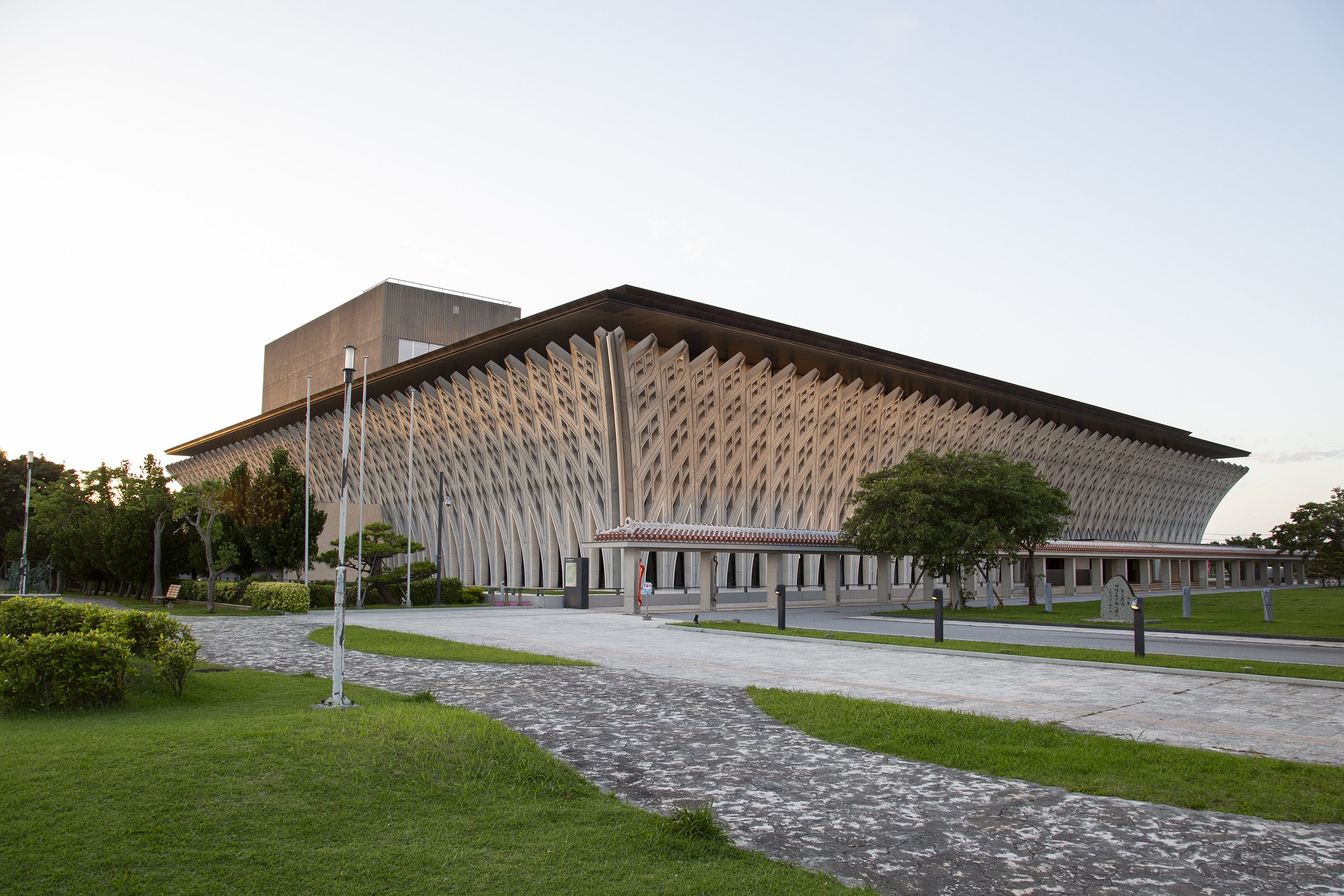
National Theatre Okinawa
414-1 Serikyaku, Urasoe City, Okinawa
Opened: January 2004
Seating capacity: Large Theater – 632 seats / Small Theater – 255 seats
National Theatre Okinawa’s program offers a rich historical and cultural tapestry, from kumiodori1 —recognized as an Important Intangible Cultural Property by the Japanese government—to folk performing arts rooted in everyday life across the Okinawan region. We spoke with Shinji Kinjo, the only artistic director at a national theater dedicated to Japan’s traditional performing arts, about performance and theater in Okinawa.
- What is the significance of having a national theater in Okinawa, and what do you think about Okinawan performing arts more generally?
- It’s not like there are national theaters everywhere across the country, so when we consider why there might be one in Okinawa, I think you can see its role as an intermediary point connecting the Japanese mainland with overseas trading partners like China and Korea. Okinawan performing arts also boast remarkable variety—a full toolbox, you might say. That’s true for well-known forms such as Ryukyuan dance2 and kumiodori, but also for the accompanying music, which features a range of traditional instruments. To look at the sanshin itself, for example, this instrument alone spans a broad spectrum, used in many songs from classical music to folk, not to mention its use in Okinawan theater.3
In that sense, the people keeping the traditional performing arts alive are often found among the general public, not just in the world of classical performance. Local folk styles are also an important part of Okinawan performing arts. So, I think of Okinawa as a place where there’s a real familiarity to the performing arts. We run this theater with a sense of responsibility to capture this multiplicity as much as we can and offer it to the audience.
Even I don’t know why we’ve ended up having an artistic director [laughs], but maybe it’s because of how essential it is to have someone who understands Okinawan performing arts in their entirety. The sheer range and variety certainly attest to that.
-
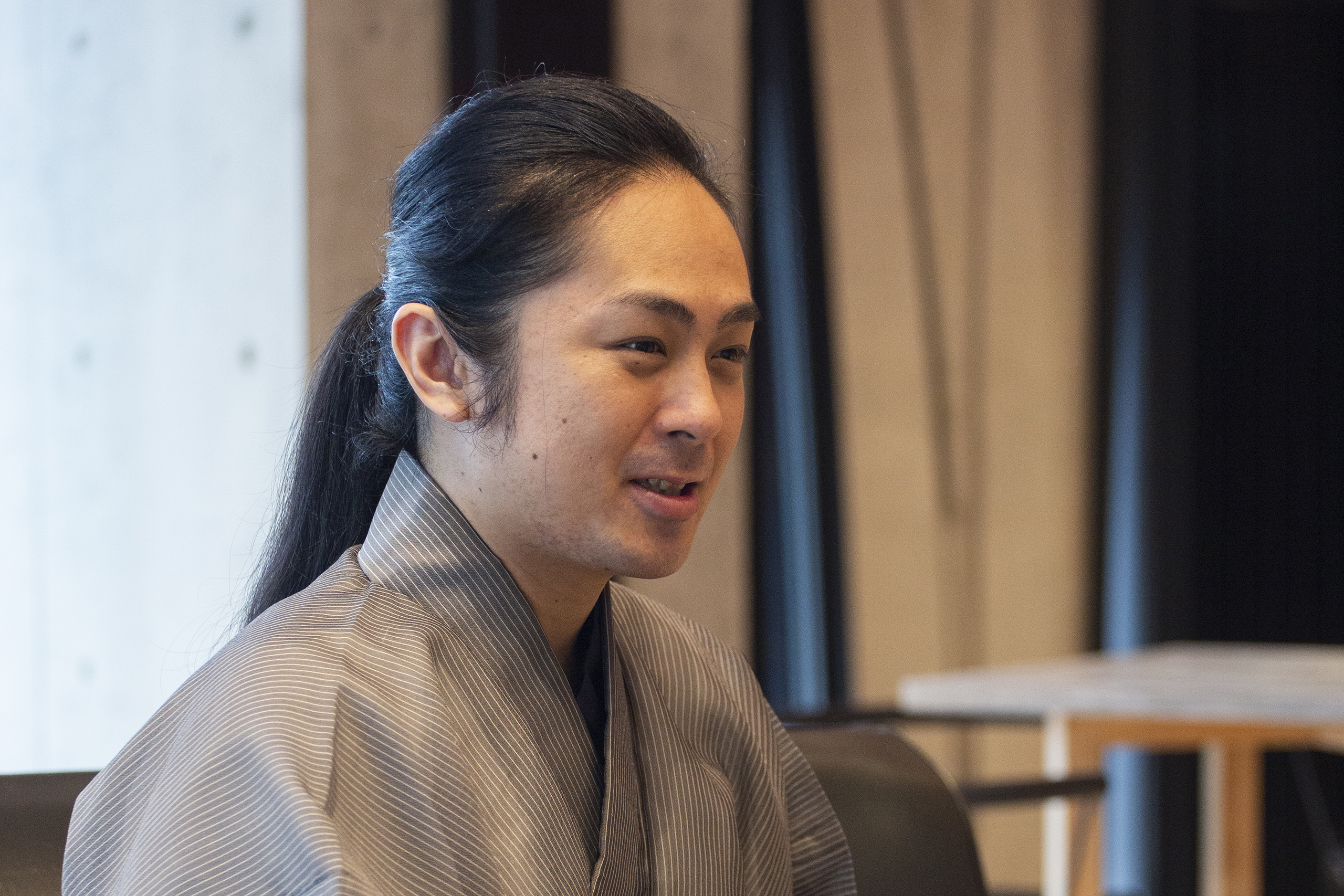
Shinji Kinjo
- How exactly do you choose what kind of performances to put on at the National Theatre?
- We organize the performances into several categories through the year. We have regular performances of Ryukyuan dance, kumiodori, sanshin music, and Okinawan theater. We also organize events for folk performing arts at least once a year, as well as for performing arts from the wider Asia-Pacific region. In principle, we bring in performers currently active at the forefront of Ryukyuan dance, sanshin music, Okinawan theater, and kumiodori to perform in our main productions. For outreach performances aimed at audiences just beginning their journey with these genres, we also feature younger performers in each field.
-
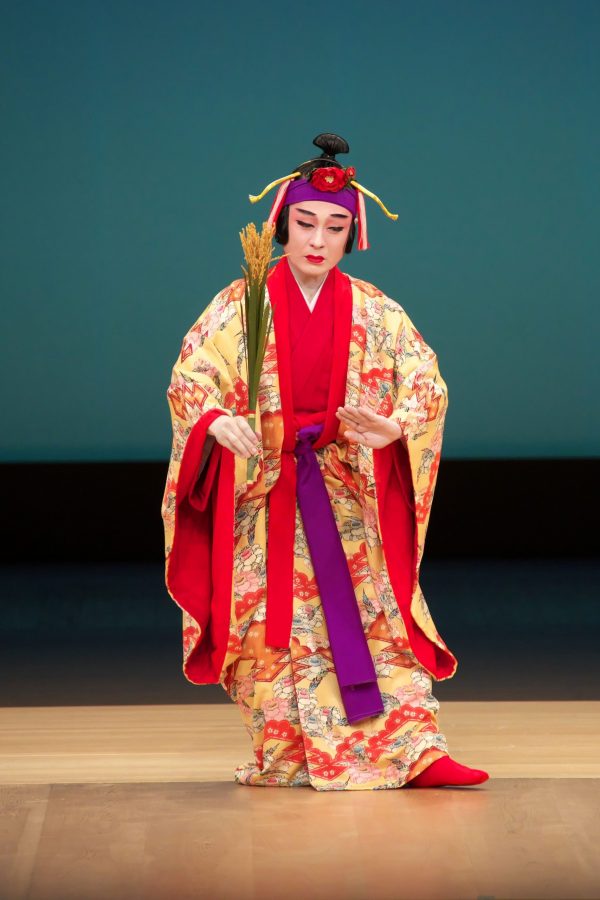
Classical Female Dance Inamadzun – Shinji Kinjo
Ⓒ National Theatre Okinawa Management Foundation
- You mentioned “outreach.” I think some people may feel like traditional performing arts are a bit daunting. Are you working on any initiatives that communicate their appeal and make them more accessible?
- As you say, the reality is that some works can be daunting. But I don’t think that applies to all of them, and Okinawa’s great in that way. For example, quite a few people have learned kajadifu4 through local neighborhood associations or women’s groups, or have a fan for dancing at home. Since this theater was established, we’ve been able to show various Okinawan performing arts programs at elementary and junior high schools, and to hold annual kumiodori workshops with the local city of Urasoe. During the summer vacation, we organize outreach events for children and parents, giving tips to help them enjoy the performances and providing an opportunity to try out the instruments during the in-class music programs. We’re helping people take that first step in a fun, engaging way. We really hope that these initiatives help people enjoy everything a bit more, and that encourages them to come and see slightly more challenging performances.
We now have a level of visitors from abroad that would have been unimaginable four or five years ago. I think we’re seeing this increase because of our theater’s website being available in nine languages, and the flyers we distribute at a nearby harbor for cruise ships. Within the theater itself, we always make announcements in English, Chinese, and Korean, and also give simple explanations of the performances in those languages.
- When it comes to passing down the traditions and training younger performers, are people emerging to carry the mantle of Okinawan traditional performing arts?
- There aren’t many people from my own generation, but occasionally someone in their 20s suddenly arrives on the scene. A kumiodori training program5 was launched the year after the theater opened, and it accepted its seventh class of trainees in 2025. Graduates of the program go on to perform in our independent productions. Most of the trainees already have experience when they come to us, and we’re very grateful to say that we currently have more applicants that we can accept. Having said that, they won’t all be able to go on to make a living in the performing arts, so we’re always thinking about what we can do on that side of things.
-
kumiodori
Kumiodori is a form of musical dance and drama created by the royal court at Shuri during the era of the Ryukyu Kingdom to entertain envoys from the Chinese emperor, including sapposhi (envoys sent to officially invest the king of the Ryukyu Kingdom as a tributary of China). It involves dialogue, music, movement, and dance. While based on ancient Ryukyuan performing arts and folklore, it also draws from Yamato traditions such as Noh, Kyōgen, and Kabuki. In 1972, the year of Okinawa’s reversion to Japan, kumiodori was designated as an Important Intangible Cultural Property by the Japanese government.
-
Ryukyuan dance
Ryukyuan dance is a traditional form of dance from Okinawa, broadly categorized into classical dance, popular dance, and creative dance. Classical dance has its origins in performing arts for ancient rituals, and has been refined by superlative artists. Popular dance incorporates folk songs and customs into classical dance, with a focus on the lives of ordinary people. Creative dance refers to works that have emerged from the postwar flourishing of traditional performing arts.
-
Okinawan theater
In contrast to courtly forms like kumiodori, Okinawan theater portrays the everyday life of ordinary people, incorporating their voices. It is divided into two categories: lyric drama and dialect drama. Lyric drama is a form of musical dance and drama incorporating songs, dialogue, movement, and dance. Dialect drama, on the other hand, features dialogue closely resembling the Okinawan language (Ryukyuan dialect) as it was really spoken.
-
kajadifu
Kajadifu is a representative piece of Ryukyuan classical music. The work is almost always performed to open celebratory occasions such as wedding receptions, and is familiar to the ear of all Okinawans. The Okinawan pronunciation differs from the standard Japanese reading of the title as written, which would be kagiyadefu.
-
kumiodori training program
The kumiodori training program was established in 2005 to ensure the cultivation of skilled young tachikata (actors and dancers) and jikata (musicians), and to enhance the artistic skill of performers, with the objective of preserving the tradition of kumiodori. Over a three-year training period, the program aims to teach participants six representative kumiodori plays.
⑤Naha Cultural Arts Theater NAHArt
-
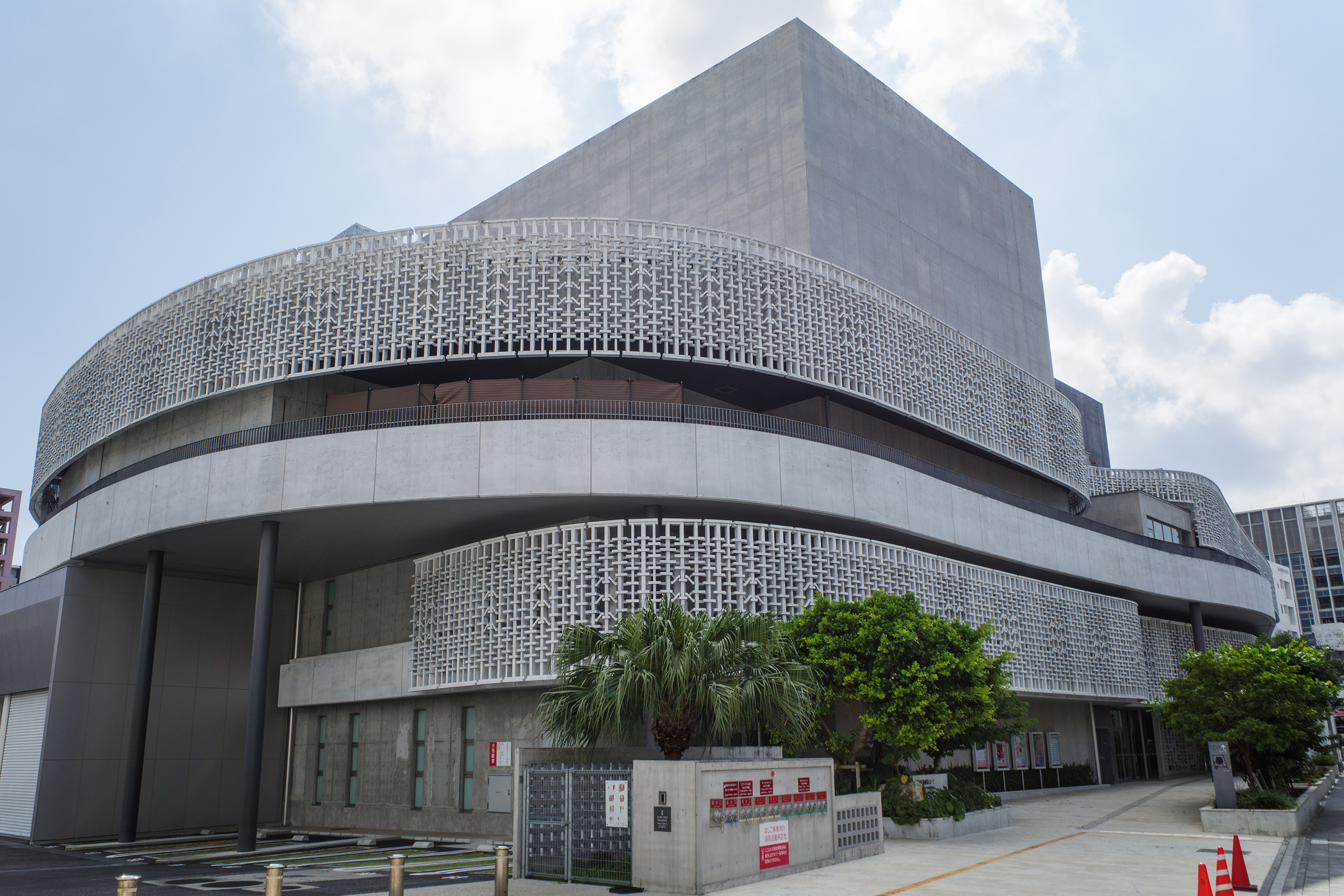
Naha Cultural Arts Theater NAHArt
3-26-27 Kumoji, Naha City, Okinawa
Opened: 2021
Seating capacity: Large Theater – 1,602 seats / Small Theater – 261 seats
Naha Cultural Arts Theater NAHArt opened in Naha City in 2021, during the COVID-19 pandemic. As an institution directly operated by the municipality, how does it handle its responsibility to engage with the local history and community while functioning as a theater? We asked Amy Hiraoka, Erina Nakamine, and Yoshiko Murakami—the venue’s lead programming and production specialists.
- Could you tell us what sets Naha Cultural Arts Theater NAHArt apart?
- Nakamine: NAHArt was built on the site of the former Kumoji Elementary School and Kindergarten. The town had developed around the school, so the local residents had some reservations and even organized a protest movement. I guess having a background like that is a distinguishing feature. Because of this situation, even before opening we worked on a number of initiatives to appeal to the community: we painted pictures on the walls of the construction site to explain how the theater would help revitalize the town, and held workshops with residents to discuss what kind of theater they would want to see, and really sought to broaden our understanding of the circumstances. Fast forward to now, and there are more restaurants around the venue, and the town has livened up; it’s gotten to the point where people say it feels a bit quiet on days when the theater’s closed.
Because of this context, I get the sense that most of the artists consider the theater’s site-specific history as a former elementary school when creating their works. Connecting with local residents is an important part of our mission, so in that way, I feel that using the site of a former school has ultimately worked out well.
Hiraoka: The space was created with the aim of providing somewhere for people to gather, even if they weren’t coming to see a play or performance, so we’ve been hosting many independent talks and other programs as well. It would be great if we can offer a facility that creates opportunities for interpersonal dialogue.
-
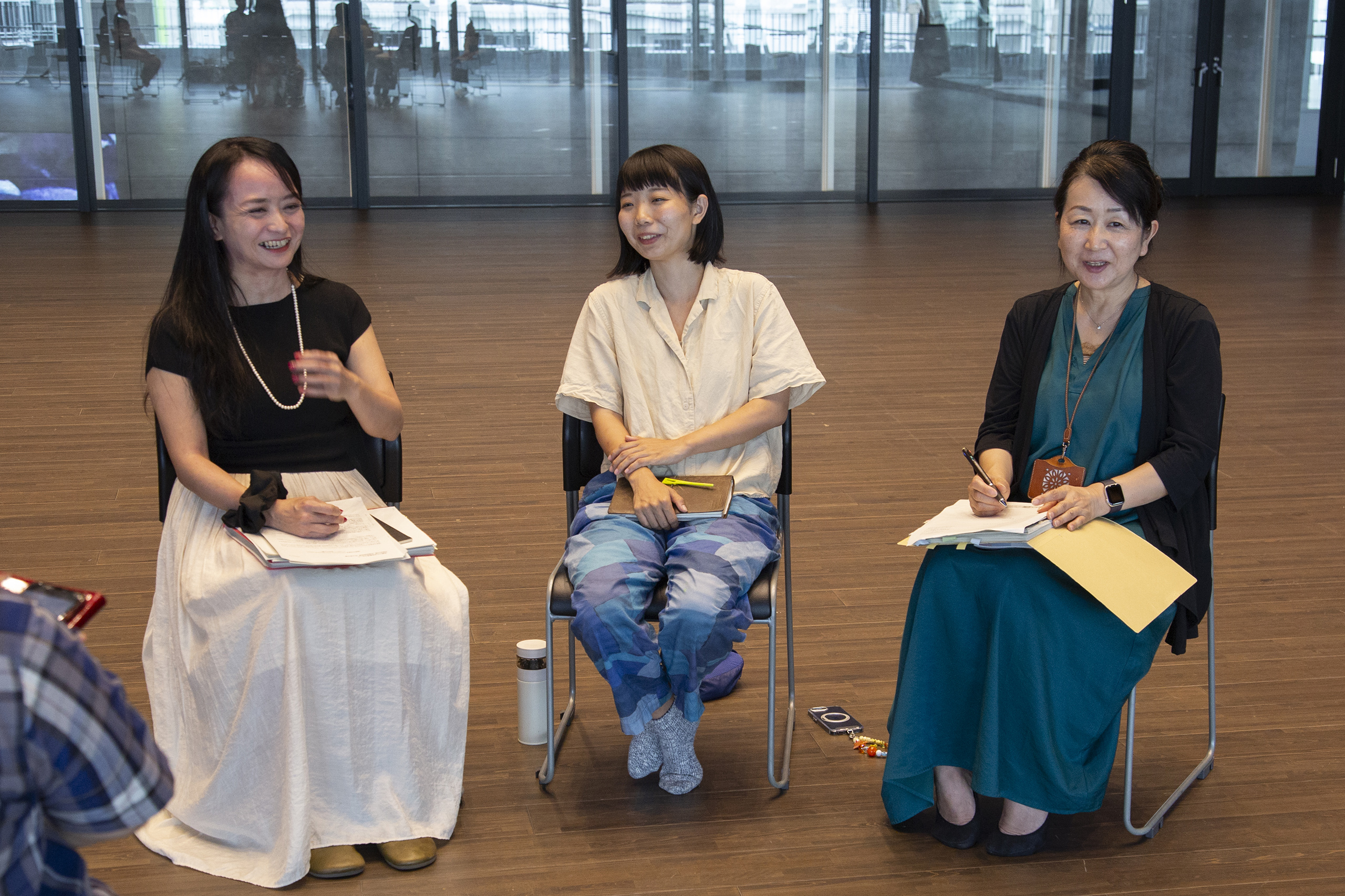
From left: Erina Nakamine, Amy Hiraoka, and Yoshiko Murakami
- Naha Civic Hall,6 which closed in 2016, was a kind of predecessor to NAHArt. The building had a long history, and was much loved by not only city residents but people around the prefecture. Could you speak to how NAHArt’s role differs, or how the two are connected?
- Nakamine: Naha Civic Hall opened two years before Okinawa’s reversion to Japan, and the people involved in its completion ceremony saw it like the establishment of a national theater. People not just from Naha but all around Okinawa came to use it, which is a reflection of the building’s significance. In its day, Naha Civic Hall mainly served as a rental hall for events and exhibitions, as a meeting place and a kind of community center.
One thing it had in common with NAHArt, now, was its aim to function as a space to cultivate traditional Okinawan performing arts.7 It was the main venue for sanshin and dance performances for many years, so locals saw it as a hub for promoting the performing arts. I think a lot of people have that impression too.
- Does NAHArt also present similar performances that feature Okinawan performing arts?
- Murakami: We organize performances with ticket prices that allow for a whole family, from children to grandparents, to attend together, with the hopes of further promoting Okinawan performing arts. We also have the “Tsunagu” program, which showcases local performing arts that have been designated as Intangible Folk Cultural Properties by Naha City. Its aim is to introduce a broader audience to performances usually only seen at regional events, while also giving performers a sense of pride in what they do by highlighting them onstage. This initiative was originally launched by Naha City’s Cultural Promotion Division in 2015, and we’ve also incorporated it into our programming since then.
-
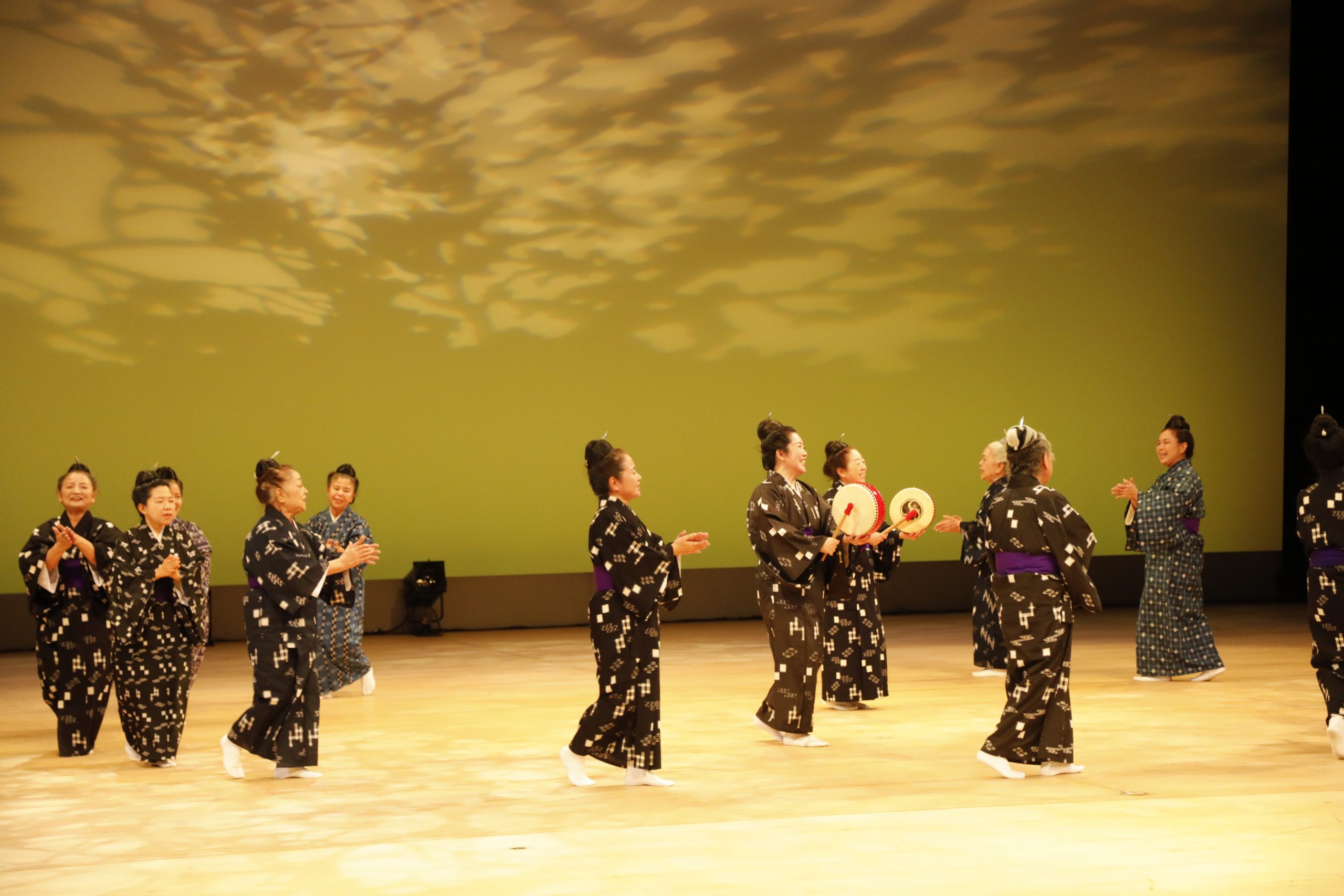
Regional cultural performance TSUNAGU
-
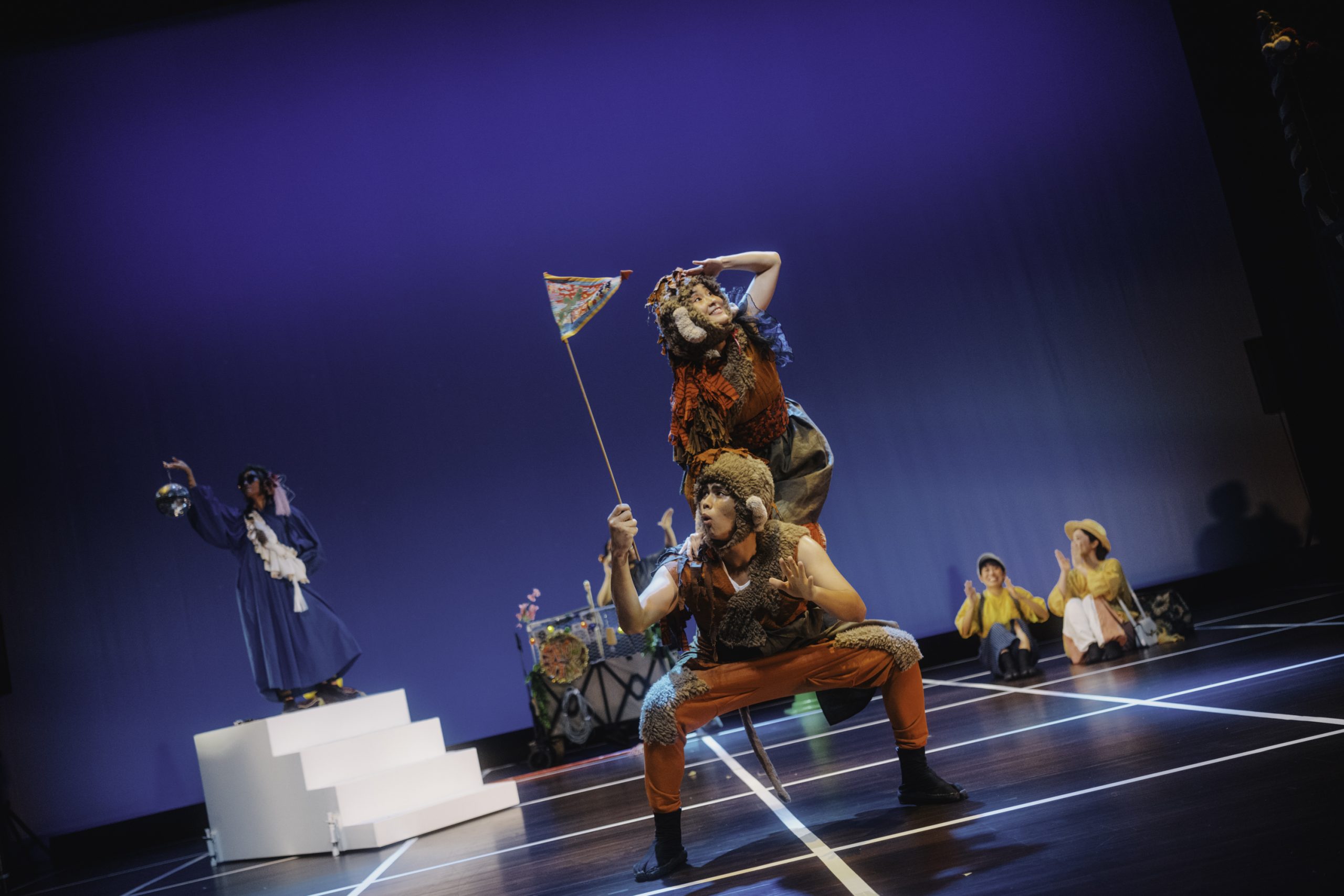
Momoko Shiraga × Takuya Kaneshima Hanauri no En on (the) Line Ⓒ Yuta Nakama
- What kind of vision do you have for the theater going forward?
- Hiraoka: NAHArt’s management plan has goals for every five years, and the first five years were about laying a foundation. We’re set to celebrate our fifth anniversary very soon, so I think our main goal from here will be figuring out how to approach social issues through arts and culture. For example, I feel that arts and culture have a role to play in addressing accessibility issues and providing opportunities for foreigners here to experience the arts.
Nakamine: We see the importance in nurturing stage professionals and creating a theater that is actually accessible and user-friendly. We also hear people talk about how going to a theater can be intimidating, so it’s crucial for us to engage even more with the question of what role a theater can play in community development.
Murakami: Some of our projects over the last four years have been one-offs, but they might have more potential, so we hope to carefully comb through everything. We would like to strengthen the relationships that we have built up to this point, and use those connections to make the next five years a period where we solidify our position. Since NAHArt is a municipally operated theater, we also want to take advantage of the benefits and coordinate with other departments to explore how arts and culture can help solve challenges in society at large.
-
Naha Civic Hall
Naha Civic Hall was established in 1970, when Okinawa was under US control, as the prefecture’s first public hall equipped with a professional stage for performances. It was built with materials gathered from across Okinawa, and incorporates methods from traditional Okinawan residential architecture. The building’s design by architect Nobuyoshi Kinjo is also highly regarded. It served as a venue for the 1972 ceremony commemorating Okinawa’s reversion to Japan, alongside the Nippon Budokan. Deterioration led to its closure in 2016, and as of May 2025, demolition works are underway.
-
traditional Okinawan performing arts
Okinawa, which once flourished as the Ryukyu Kingdom, has developed its own distinctive performing arts influenced by neighbors such as China, Japan, and other southeast Asian countries. Okinawan performing arts can be broadly divided into two categories: courtly performing arts such as kumiodori and okansenodori; and folk performing arts such as shishimai, eisa, and folk songs.
-
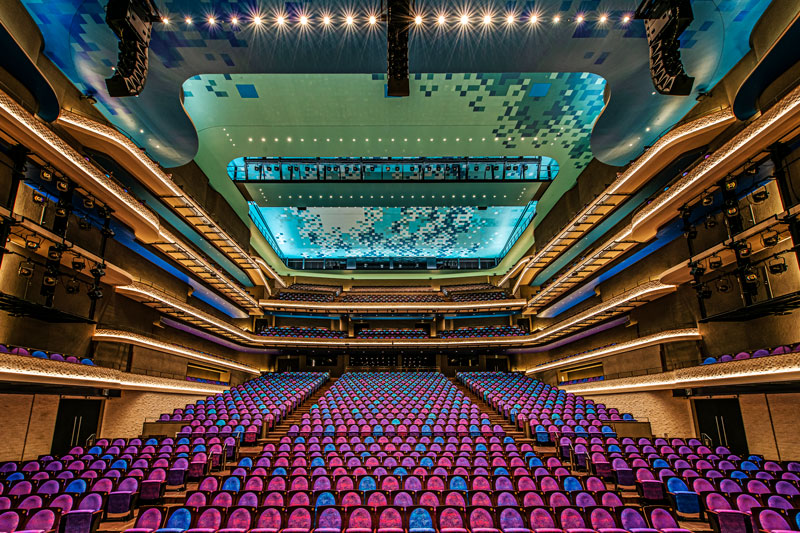
ⓒ Naha City
-
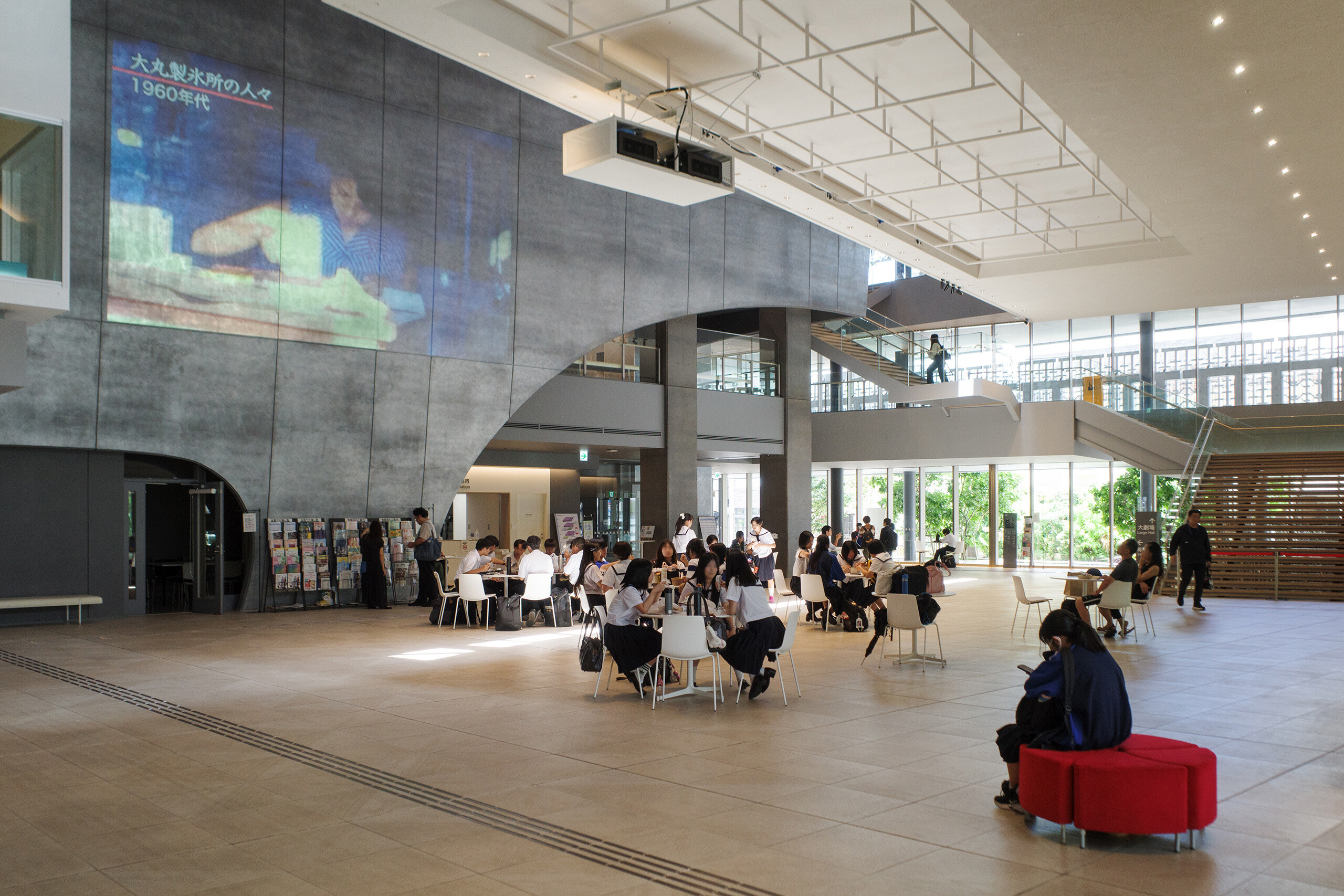
Okinawa Series – Map of All Featured Locations
<Column>⑥–⑫ Exploring Okinawa through the Cultural Spots
Okinawa’s complex and singular history has cultivated a unique regional culture. Here are a few spots we recommend visiting to provide more context to the performing arts showcased at the theaters we have introduced, and to deepen your understanding of Okinawa.
The Battle of Okinawa, in 1945, was the only ground battle fought on Japanese soil during World War II. Around 200,000 people lost their lives, including civilians. Our first recommendation is the Sakima Art Museum in Ginowan City—located just next to the United States Marine Corps Air Station Futenma8 —a space that confronts the tragedy of war with the power of art. Following the route from the entrance through the various permanent exhibits and arriving at the third gallery, one is struck by the overwhelming emotional force and intellectual provocation of The Battle of Okinawa, a work into whichhusband-and-wife duo Iri and Toshi Maruki9 poured their souls.
Museum Director Michio Sakima has stated that the themes of the collection are life and death, suffering and salvation, and humanity and war. After taking in the artworks within the museum, we suggest climbing the 6+23 steps, corresponding to June 23—Okinawa Memorial Day,10 which commemorates those lost in the Battle of Okinawa—and ascending to the rooftop to see the view over Air Station Futenma.
-
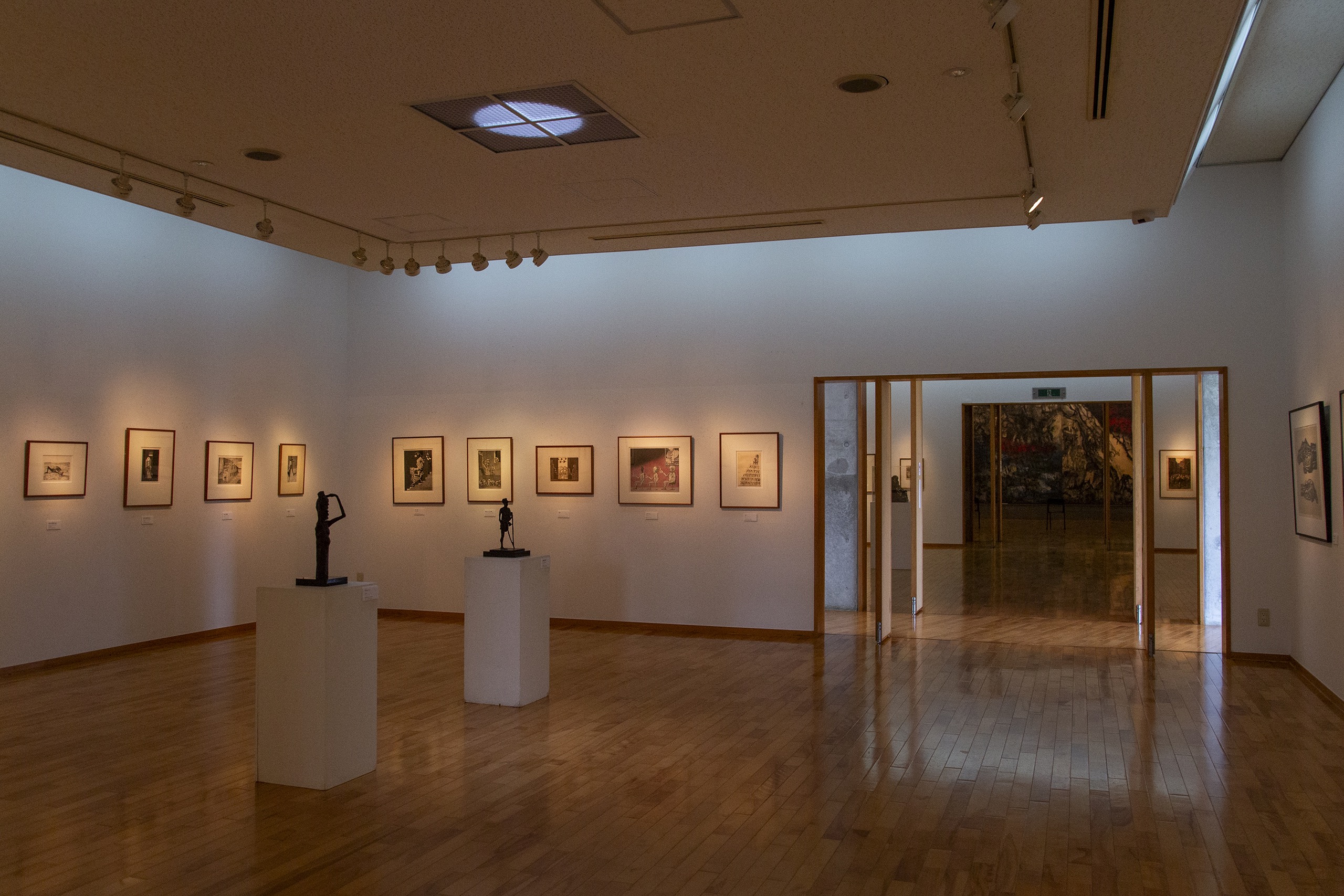
Sakima Art Museum (Ginowan City)
358 Uehara, Ginowan City, Okinawa -
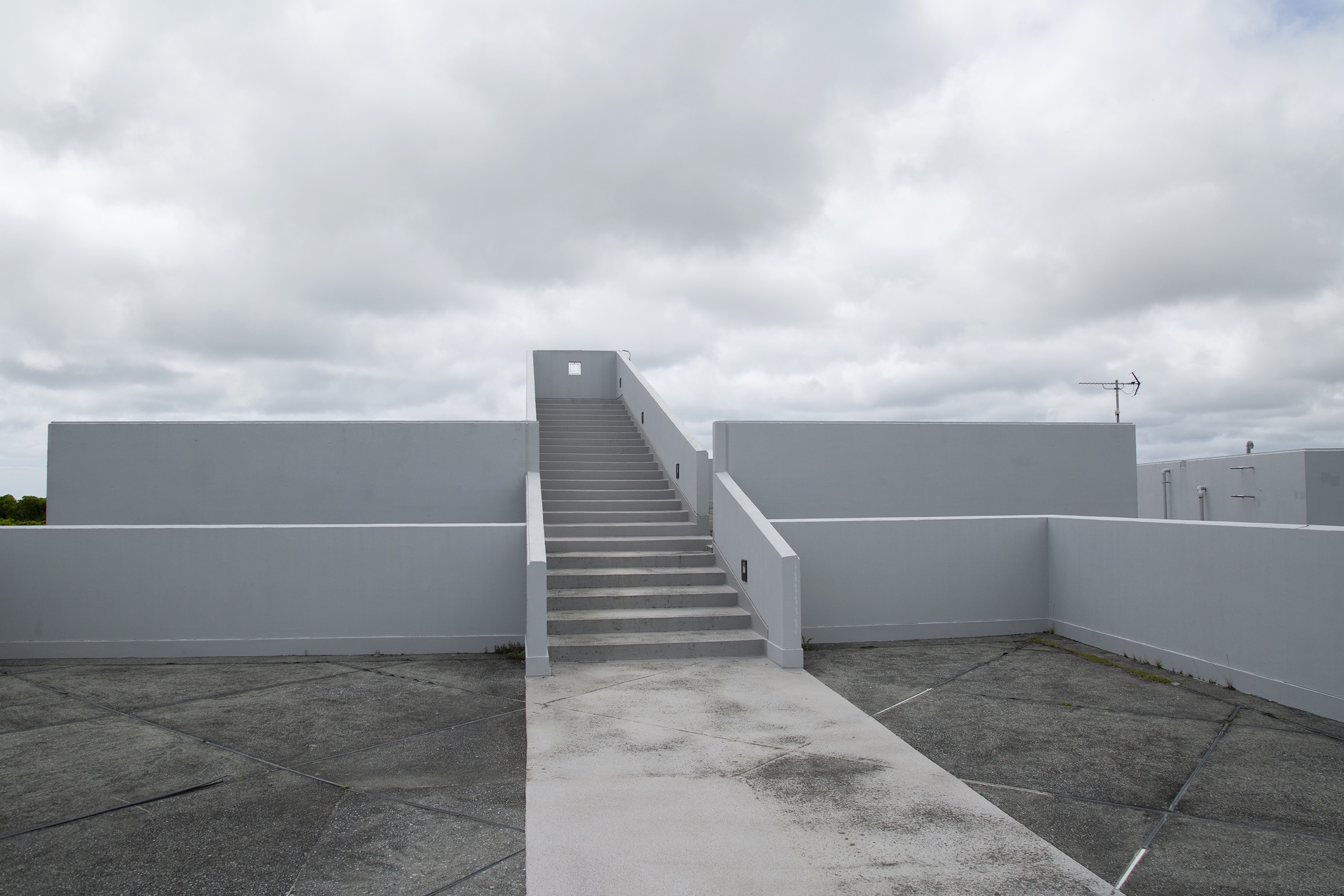
The rooftop window is designed to let in the sun on Okinawa Memorial Day.
A roughly ten-minute drive northeast from the Sakima Art Museum takes you to the huge Rycom shopping mall (AEON MALL Okinawa Rycom), which features in the title of one of acclaimed young playwright Takuya Kaneshima’s best-known works. Continue further north, and you arrive at Koza, Okinawa City, an area busy with US military personnel from Kadena Air Base11 that has a unique atmosphere directly influenced by American culture. This is where you’ll find the hidden-gem Theater Donut (commonly known in Japanese as “Shia-Do”). The theater’s manager and Koza native, Shinichi Miyajima, witnessed the changes in his town while growing up as a movie buff. That experience shapes his decisions about which films he most wants to show people now.
Shia-Do’s most distinctive feature is that all screenings include an introductory and closing remarks from Miyajima himself. Even after a film based somewhere else in Japan, or in some other country, his words can act as a bridge between the here-and-now of Koza, and a scene from the movie. Why not stop to feel the atmosphere and have a yuntaku (Okinawan for “chat”) with Shia-Do’s visitors?
-
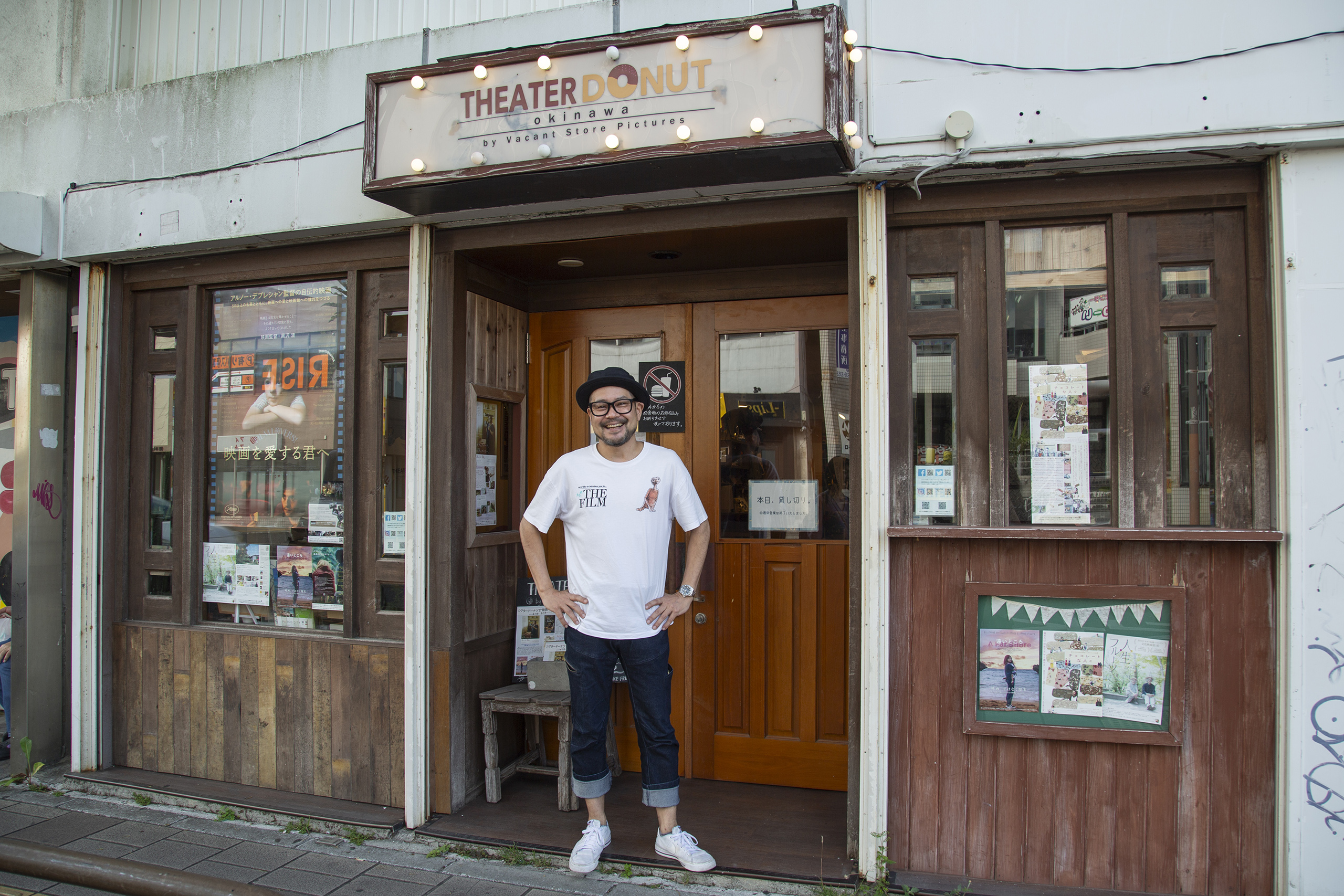
Theater Donut (Okinawa City)
1-3-17 Chuo, Okinawa City, Okinawa
Representative: Shinichi Miyajima -
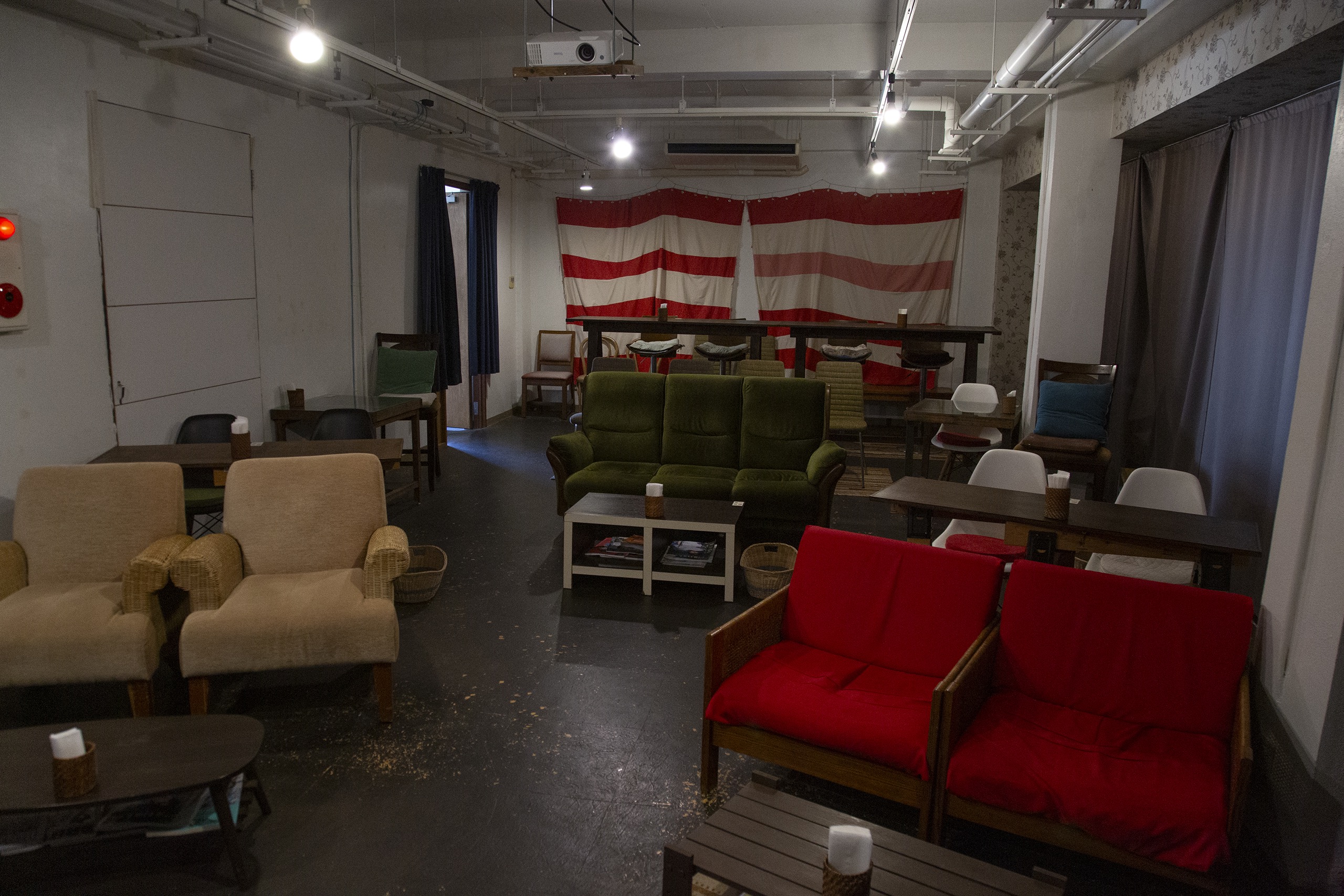
Cozy theater rooms like a café are located on both the first and second floors.
According to Miyajima, Shia-Do is Okinawa Prefecture’s northernmost movie theater. If you drive another ten minutes or so northwest, you’ll arrive at Roadside Station Kadena, where you have a view of Kadena Air Base, which straddles Okinawa City, Chatan Town, and Kadena Town. After witnessing the enormity of the base from the fourth-floor observation deck, visitors can learn about the current reality of the town as the host of a military base, as well as its pre- and postwar history by heading to the third-floor educational exhibition space, renovated and reopened in 2023.
-
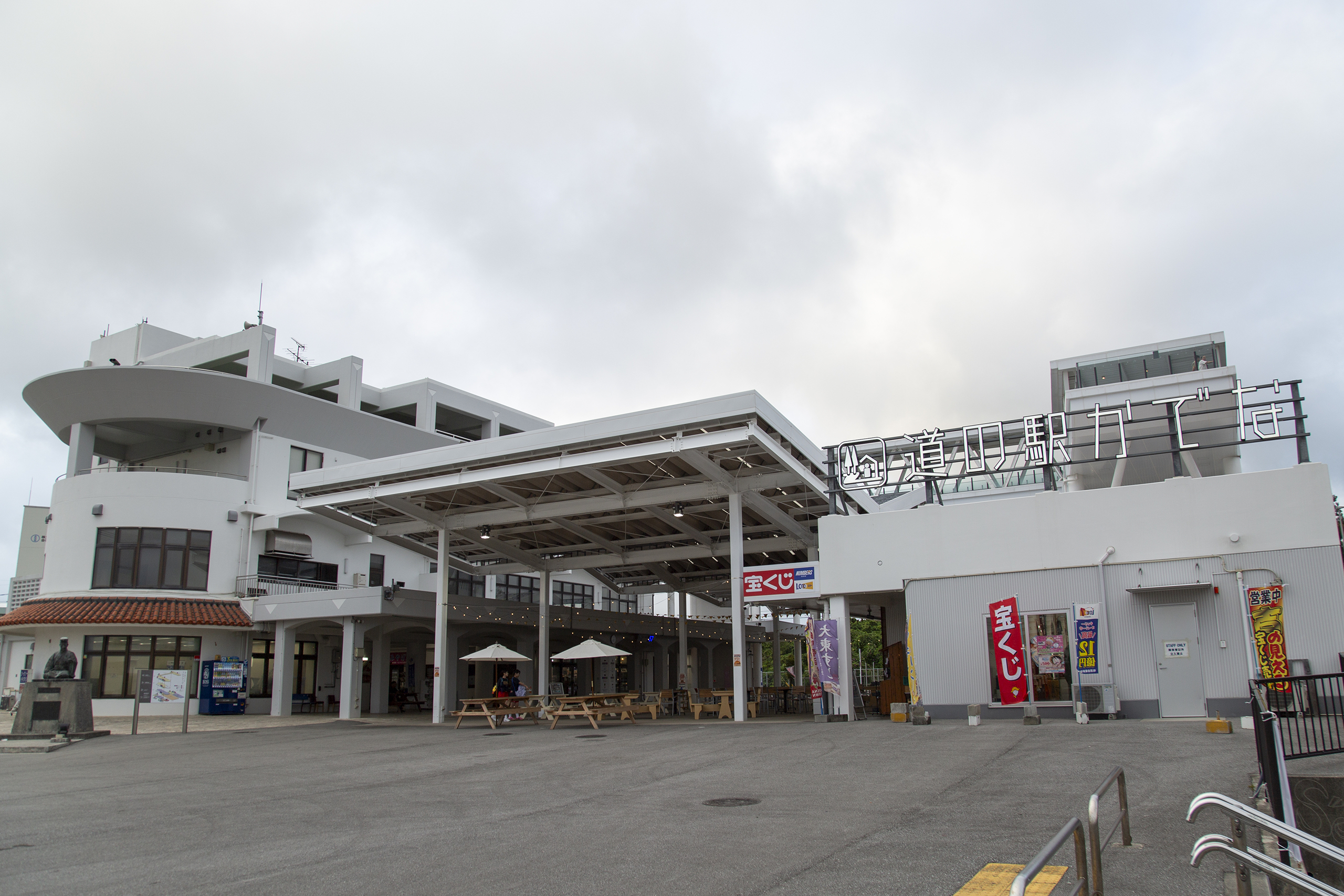
Roadside Station Kadena (Kadena Town)
1026-3 Yara, Kadena Town, Nakagami District, Okinawa -
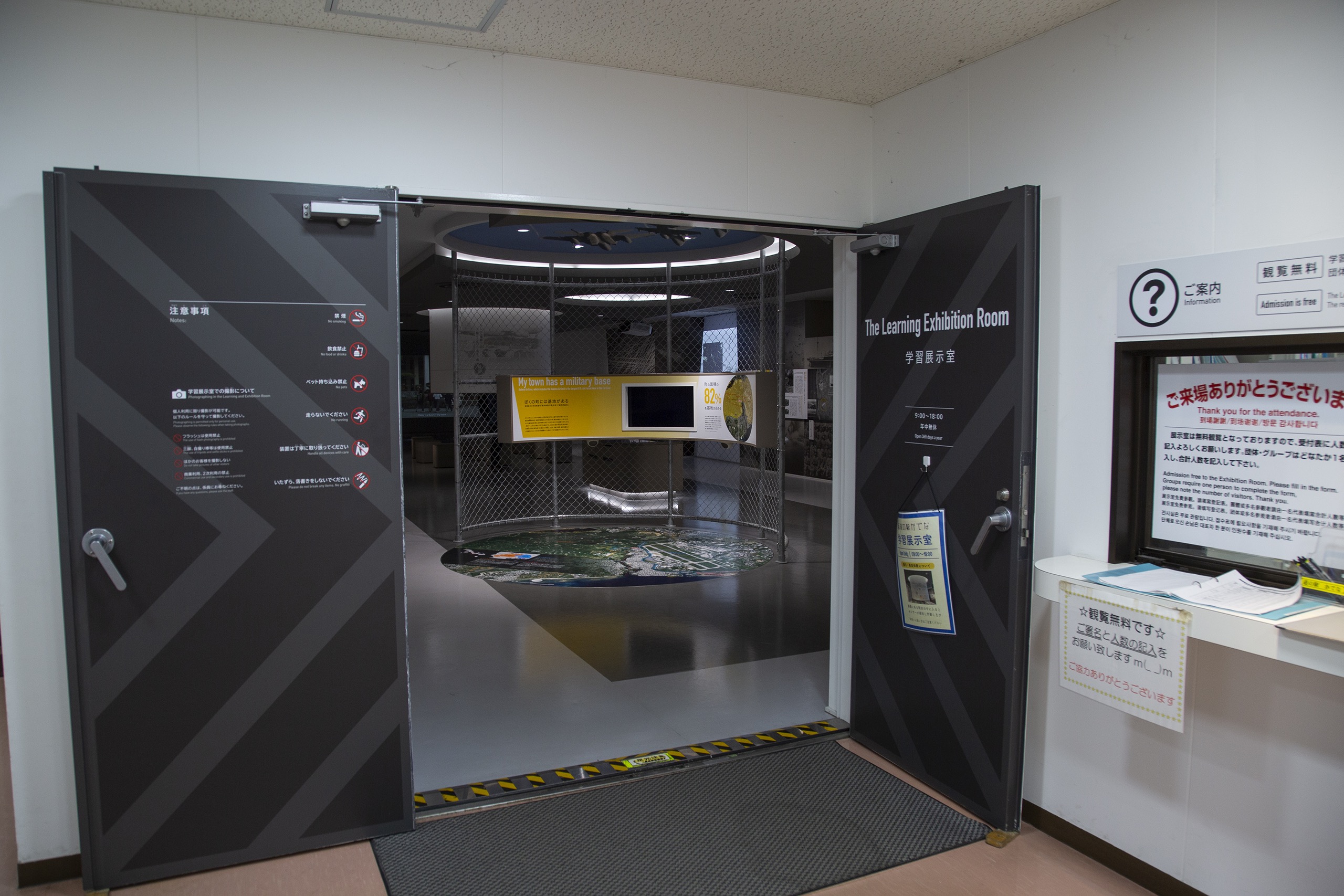
On the third floor is an exhibition room where visitors can learn about the base town of Kadena.
After a tour of the central area, which is heavily affected by the US military bases, let’s move south to Naha, the prefectural capital. Close to the Makishi Public Market,12 which played a part in Okinawa’s postwar reconstruction and supported the lives of the prefecture’s residents, is our fourth recommendation: Sakurazaka Theater. Steeped in history, the building was originally opened in 1952, shortly after the war. It was a small playhouse staging Okinawan theater called “Sangoza.” It was converted into a movie theater the following year. Since then, it has weathered financial hardship and established itself as a unique space that serves as both a neighborhood cinema and cultural beacon. As well as films related to Okinawa, it also screens art house cinema and hosts events such as live music and comedy. The venue also operates a program of workshops called “Sakurazaka Citizens’ University,” which offers courses on film, screenwriting, and Okinawan culture. Watching a film at Sakurazaka Theater—which began by staging Okinawan theater, perhaps the only form of entertainment available to locals after the war left much of the region a burnt-out ruin—is sure to be a standout experience.
-
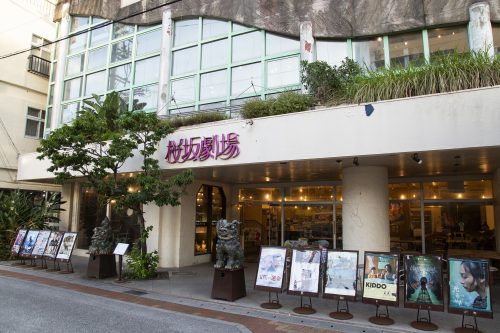
Sakurazaka Theater (Naha City)
3-6-10 Makishi, Naha City, Okinawa
Finally, we would like to touch on Okinawa’s publishing culture. The region is home to many small, local publishers, and has developed a unique publishing culture. Books published by publishers within the prefecture (henceforth referred to as prefecture-published books), and they have continued to line bookshop shelves from the postwar period until today. There are also countless titles that have gone out of print without any subsequent run. The best place to find any books published in the past, then, is the Okinawa Prefectural Library.
The entire fifth floor of the library, which is located within a commercial building, houses books relating to Okinawa, and there is a local history room for important materials and prefecture-published books. Altogether, the library boasts a collection of 347,268 books (as of June 2024). Although the library doesn’t cover everything, if you’re looking for information about Okinawa, you’ll almost certainly be able to find something relevant.
If you want to check out the latest prefecture-published books, try recommendation number six: Junkudo’s Naha branch, located in Naha City’s Makishi area. One of the first things you’ll notice is the large sections dedicated to books about Okinawa, along with the latest releases and popular titles displayed year-round. The section for books on Okinawa also has many prefecture-published books, categorized by genre including history, economics, society, culture, art, music, and photography. Once you start browsing, you realize you’ll never have enough time. In addition, long-established second-hand bookstores in the prefecture carry many used prefecture-published books that are unavailable at new bookshops. You might just stumble across a hidden gem you’d never have found at the library or Junkudo.
-
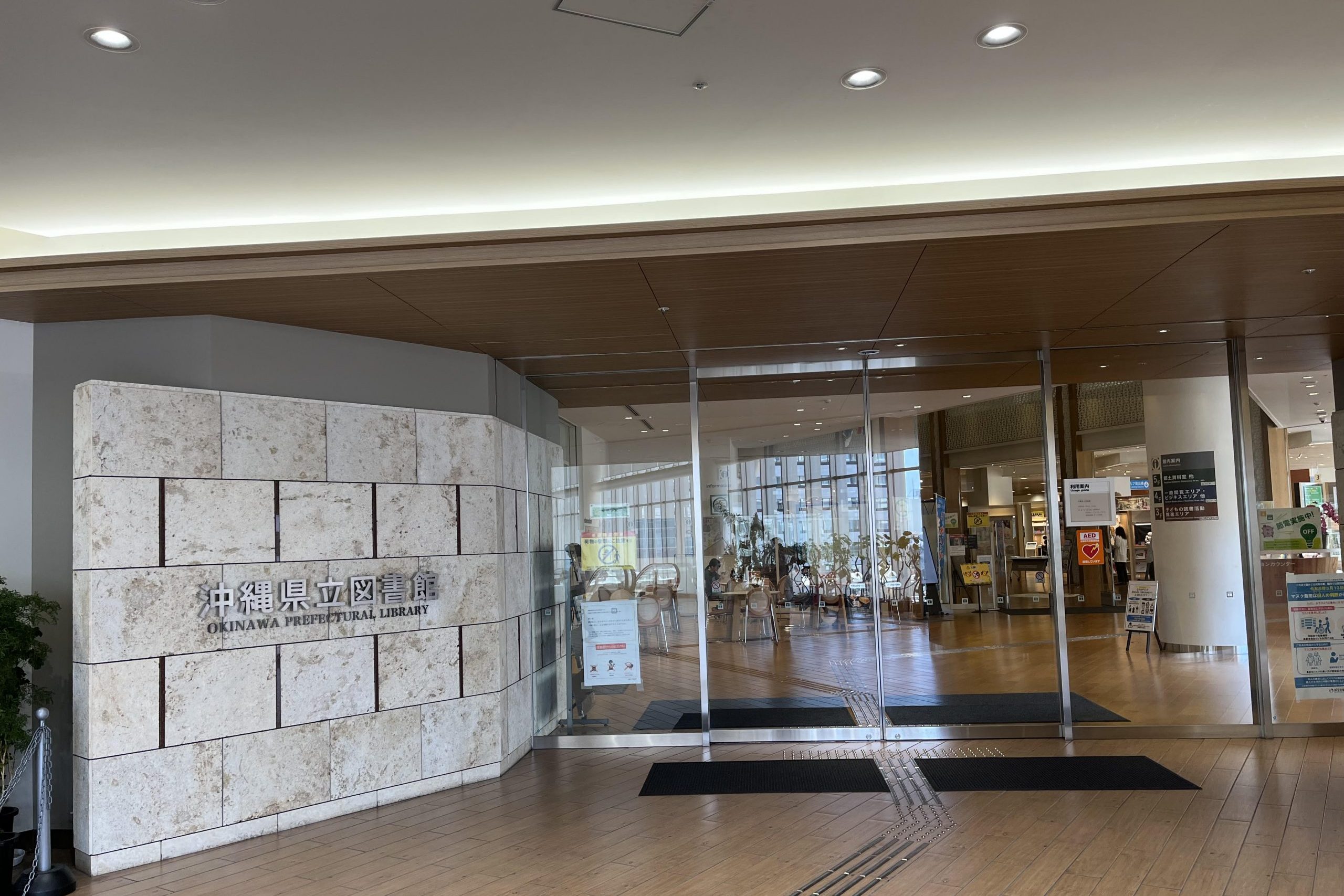
Okinawa Prefectural Library (Naha City)
1-20-1 Izumizaki, Naha City, Okinawa
Kafoonah Asahibashi A Block, 6th Floor -
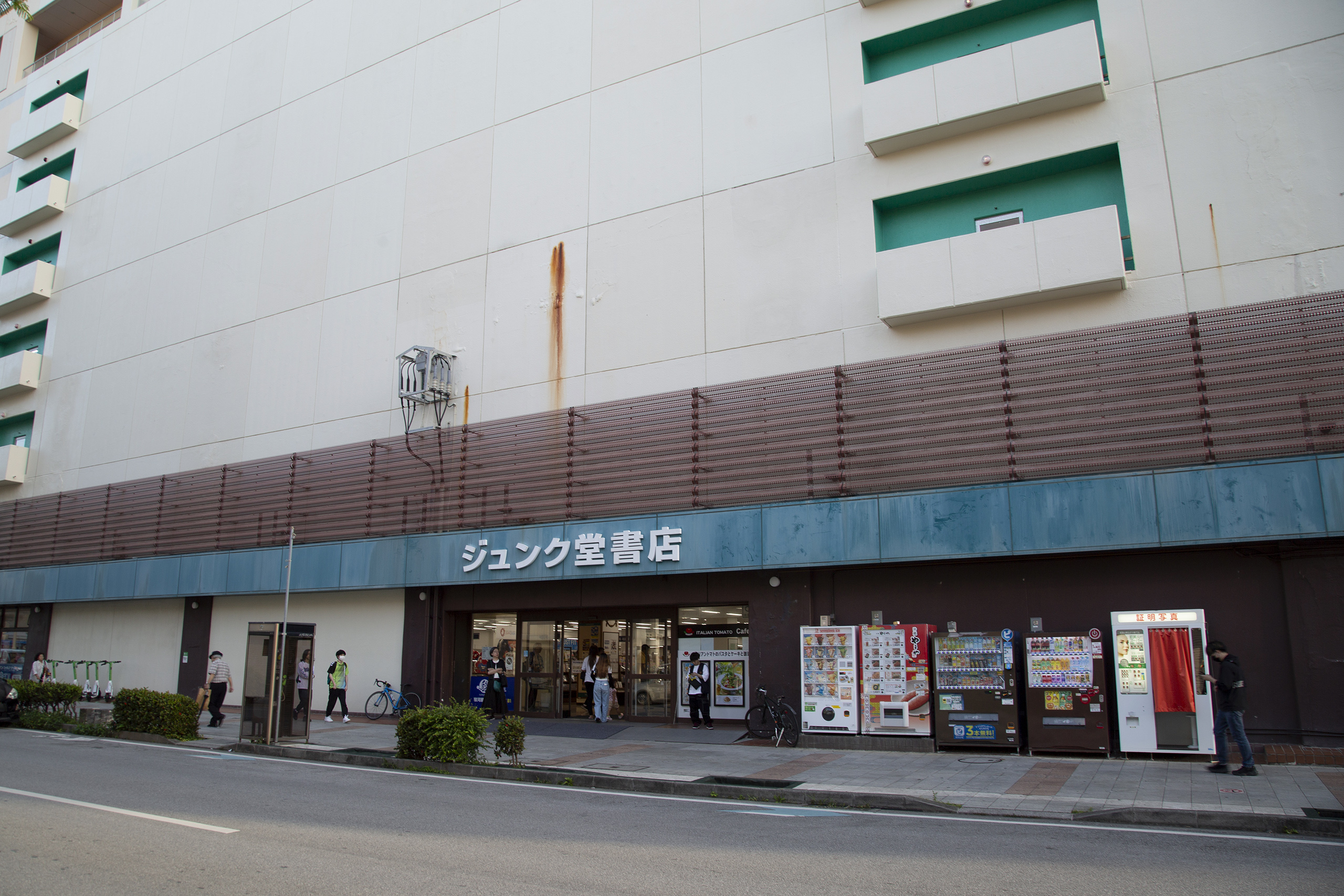
Junkudo, Naha (Naha City)
1-19-29 Makishi, Naha City, Okinawa
D-naha
-
United States Marine Corps Air Station Futenma
United States Marine Corps Air Station Futenma is a marine corps air base located in the center of Ginowan City, occupying approximately 25% of the city’s total area.
-
Iri and Toshi Maruki
Iri Maruki (1901–1995) was highly praised before World War II for her distinctive ink paintings. Toshi (1912–2000) was an oil painter and picture book artist, producing many oil paintings and illustrations. The duo created various works as a couple after their marriage in 1941.
-
Okinawa Memorial Day
Okinawa Memorial Day, June 23, is a commemorative day that was established by the prefecture to mourn the loss of life at the Battle of Okinawa. A memorial service for the war dead is held at Peace Memorial Park in Itoman City’s Mabuni area every year.
-
Kadena Air Base
Kadena Air Base is located in the center of the island of Okinawa and spans the towns of Kadena, Okinawa City, and Chatan. It is known as the largest US Air Force base in the Far East.
-
Makishi Public Market
Makishi Public Market is a public market in Naha City that has come to be affectionately known as the kitchen of the city and prefecture’s citizens. The black markets that had proliferated after the War were consolidated in 1950, when they opened as Makishi Public Market, operated by Naha City.
-
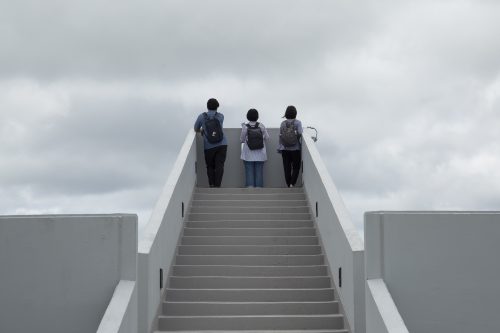
Photo: Naoko Kitaue
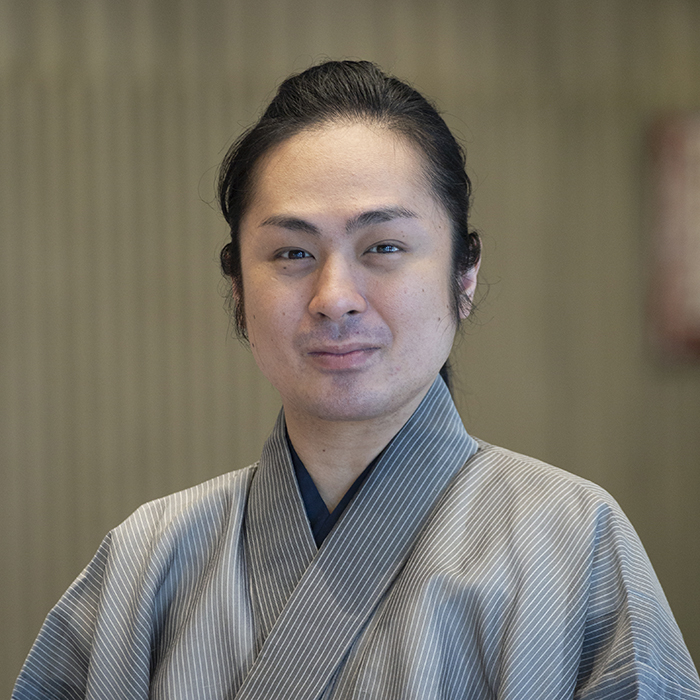
Photo: Naoko Kitaue
Shinji Kinjo
Born in 1987, Shinji Kinjo began training in Ryukyuan dance under Yoshiko Tanida and Mieko Kinjo of the Tamagusuku Ryu Senjukai from an early age. He completed National Theatre Okinawa’s kumiodori training program, and is a graduate of the Ryukyuan Dance and kumiodori graduate program at Okinawa Prefectural University of the Arts’ Department of Performing Arts. He is recognized as a custodian of Ryukyuan Lyric Drama, an Intangible Cultural Property designated by Okinawa Prefecture, and received the Okinawa Times Encouragement Award (Theater). The inaugural Kinjo Shinji no Kai—Mai Jojo [Shinji Kinjo: Dance, Lyricism] was held in 2017 at the National Theatre Okinawa’s Large Theater. The second installment, Kinjo Shinji no Kai—Mai Shunkyo [Shinji Kinjo: Dance, Spring Delight], was held in 2022 at the Ryukyu Shimpo Hall. Kinjo was appointed National Theatre Okinawa’s Artistic Director in April 2022. He is a certified master of the Tamagusuku Ryu Senjukai, and remains active as a performer, instructor, and director, focusing on Ryukyuan dance, kumiodori, and Okinawan theater.
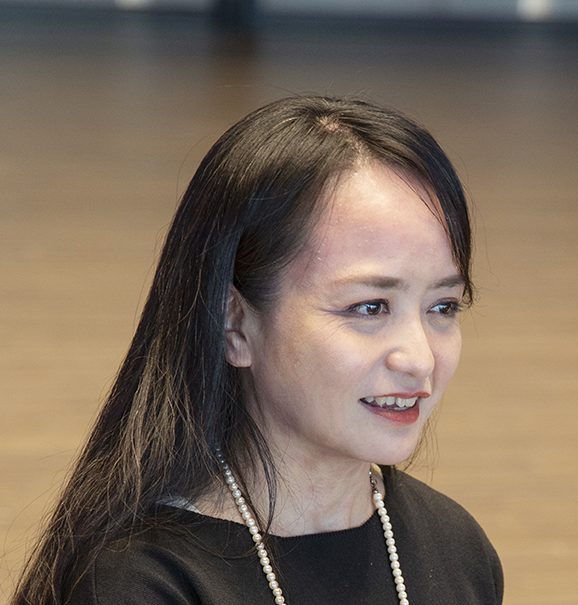
Photo: Naoko Kitaue
Erina Nakamine
Born in Okinawa Prefecture, Erina Nakamine is a graduate of the Department of Fine Arts at Okinawa Prefectural University of Arts, where she also completed a master’s degree in Theater Arts. She has worked at museums throughout the prefecture as a curator specializing in art and crafts from the era of the Ryukyu Kingdom through to modern Okinawa, and joined Naha Cultural Arts Theater NAHArt as a Planning and Production Manager and Curator in 2021. Nakamine has been responsible for the planning and production of contemporary art exhibitions and stage performances at NAHArt, with projects including exhibitions such as Chiharu Shiota’s The Shape of Life and Yuken Teruya’s Chorus, the Ryukyuan performing arts stage work Kokera Otoshi no Gi to commemorate the venue’s opening, and Yuken Teruya’s Okinawan adaptation of the opera . She is also active as a Ryukyuan dance performer, and received an honorable mention at the 6th National Theatre Okinawa Creative Dance Awards. She heads the Ryubu Kenkyujo (Ryukyuan Dance Research Institute), and also works as a part-time lecturer at the Okinawa Prefectural University of Arts.
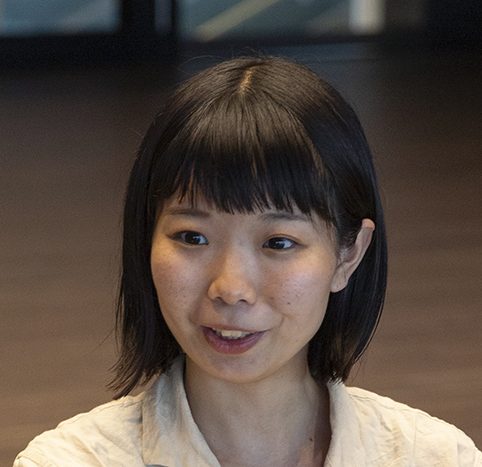
Photo: Naoko Kitaue
Amy Hiraoka
Born in Tokyo in 1994, Amy Hiraoka is Naha Cultural Arts Theater NAHArt’s Planning and Production Manager. She has been a Naha resident since 2016. Prior to taking on her current position in 2020, Hiraoka was a program officer at the Okinawa Prefectural Foundation for Cultural Promotion, Okinawa Arts Council. She has been working with the institution since before its opening in 2021, and oversaw the production of Mum & Gypsy’s Light house during the theater’s inaugural year, the NAHArt JAZZ Month concert in 2023, and the NAHArt Baby Theater Project in 2024. As a personal project, Hiraoka has been running a shared house and artist-in-residence facility since 2017.
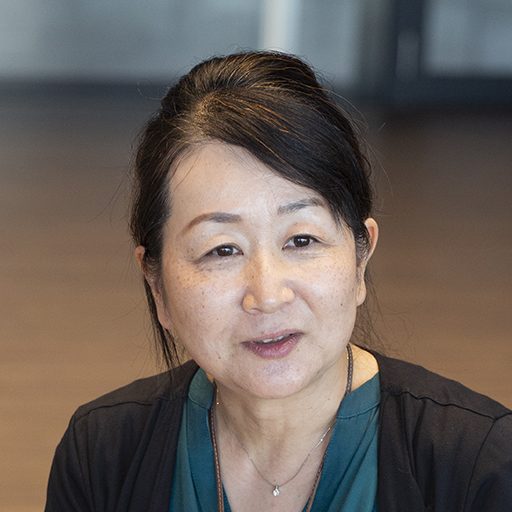
Photo: Naoko Kitaue
Yoshiko Murakami
Born in Ehime Prefecture, Yoshiko Murakami currently serves as a Planning and Production Manager at Naha Cultural Arts Theater NAHArt. She has resided in Okinawa since 2002. Murakami has held her current position since the theater’s inauguration in 2021. Murakami has overseen projects such as the 2021 local performing arts program Tsunagu, the 2022 historical play The Surrender of Shuri Castle, the 2023 Donatsuban kara no utagoe: Okinawa minyo saiseiki no jonetsu (Voices from vinyl: Passion for the golden age of Okinawan folk songs), and the 2024 production Ryukyu shoshima fubutsushishu: Sonosuke no yonda Okinawa (Scenes of life from the Ryukyu islands: Okinawa as composed by Sonosuke). In her personal practice, she has been learning uta-sanshin (songs accompanied by the sanshin) since 1997. She is currently recognized as a designated custodian of multiple important intangible cultural properties: the national government has designated her as such with respect to the Intangible Cultural Property Ryukyuan Dance (sanshin accompaniment); and Okinawa prefecture has so designated her with respect to both Ryukyuan Lyric Drama (sanshin accompaniment) and Okinawan Traditional Music of the Nomura School. Murakami is a master in both Ryukyuan Classical Music of the Nomura School and Ryukyuan Folk Song.


